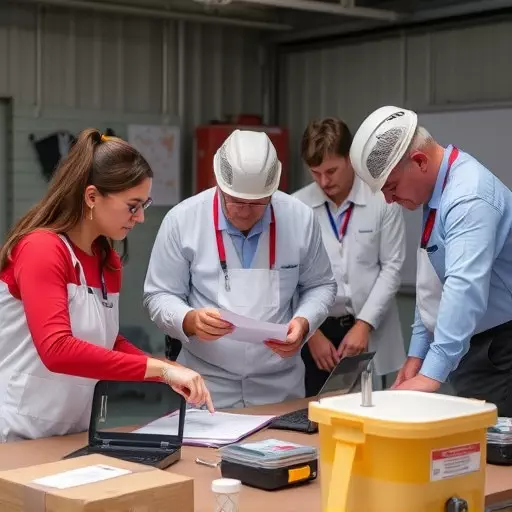Process Hazard Analysis (PHA) has evolved to address cybersecurity risks alongside traditional threats, leveraging expert teams and specialized software. These facilitators employ various hazard identification techniques, from facility walkthroughs to advanced analyses like decision trees and fault tree analysis. With industrial processes becoming increasingly interconnected and data-driven, integrating cybersecurity into PHA is vital. By upgrading facilitation tools with advanced threat modeling and risk assessment capabilities, experts can help industries identify and mitigate both cyber and process hazards, enhancing safety and resilience.
“In today’s digital age, Cybersecurity is no longer an afterthought but a core consideration in industrial safety protocols. Process Hazard Analysis (PHA), a critical tool for identifying and mitigating risks in complex processes, must evolve to meet the demands of an ever-changing cybersecurity landscape. This article explores the intricate relationship between PHA and cybersecurity, highlighting the role of specialized facilitators, innovative digital tools, and advanced hazard identification techniques. From understanding PHA’s pivotal role to leveraging AI in risk assessment, we navigate the path toward enhancing industrial safety through comprehensive cybersecurity integration.”
- Understanding PHA (Process Hazard Analysis) and its Cybersecurity Demands
- – Definition of PHA and its role in industrial safety
- – The evolving cybersecurity landscape and its impact on PHA
- PHA Facilitation Experts: Navigating Cyber Risks
Understanding PHA (Process Hazard Analysis) and its Cybersecurity Demands
Process Hazard Analysis (PHA) is a structured method used to identify, assess, and mitigate hazards within industrial processes. Facilitated by experts, this analysis goes beyond traditional risk assessment by systematically exploring all potential failures and their consequences. PHA involves a multidisciplinary team that employs various hazard identification techniques to ensure comprehensive coverage of the process. These techniques range from walking the facility and observing operations to employing decision trees and fault tree analyses.
As cybersecurity becomes an increasingly vital consideration in critical infrastructure protection, the demands on PHA also evolve. Cybersecurity must be integrated into the hazard analysis framework, recognizing that modern industrial systems are interconnected through networks and sensitive data flows freely. Cyber threats can originate from external actors or internal users with malicious intent, posing risks to process safety, data integrity, and even physical security. Therefore, pha facilitation experts and tools must now account for these cybersecurity dimensions, leveraging specialized software and methodologies to identify vulnerabilities and develop robust defense strategies.
– Definition of PHA and its role in industrial safety
Process Hazard Analysis (PHA) is a systematic method used to identify, assess, and mitigate potential hazards within industrial processes. It plays a pivotal role in enhancing safety measures across various sectors, particularly in industries where process failures could lead to severe consequences. PHA facilitates a comprehensive review of a facility’s operations, ensuring that risks are identified early and managed effectively.
PHA facilitation experts employ specialized tools and techniques, such as what-if scenarios, fault tree analysis, and event tree analysis, as part of the hazard identification process. These methods allow for a deep understanding of system interdependencies and potential failure modes. By utilizing these techniques, PHA facilitation tools help identify not only major hazards but also minor ones that could escalate if left unaddressed, ultimately contributing to a robust safety culture within industrial operations.
– The evolving cybersecurity landscape and its impact on PHA
The cybersecurity landscape is constantly shifting, with new threats and vulnerabilities emerging regularly. This evolving nature poses significant challenges for Process Hazard Analysis (PHA) facilitation experts and the methods they employ. Traditional hazard identification techniques, which form the backbone of PHA, must adapt to incorporate modern security risks. The rise of cyberattacks targeting industrial control systems (ICS) and critical infrastructure has underscored the need for enhanced cybersecurity measures within PHA processes.
PHA facilitation tools are being updated to include advanced threat modeling and risk assessment capabilities. These tools now account for network vulnerabilities, data exfiltration, and malicious software, ensuring that organizations can identify and mitigate cyber-related hazards effectively. By integrating cybersecurity considerations into their practices, PHA experts can help industries stay ahead of potential threats, thereby improving overall process safety and resilience.
PHA Facilitation Experts: Navigating Cyber Risks
PHA facilitation experts play a pivotal role in navigating cyber risks within industrial operations. As organizations increasingly rely on digital systems and networks, the potential for cybersecurity breaches becomes a significant concern during process hazard analysis (PHA). These experts employ advanced pha facilitation tools and techniques to identify and mitigate cyber-related hazards effectively.
By utilizing specialized knowledge and hazard identification techniques, they guide teams through complex scenarios involving system vulnerabilities, malicious attacks, and data breaches. Through collaborative sessions, they ensure that PHA processes remain robust and adaptable in the face of evolving cyber threats. This proactive approach not only enhances overall process safety but also fosters a culture of cybersecurity awareness within the organization.


